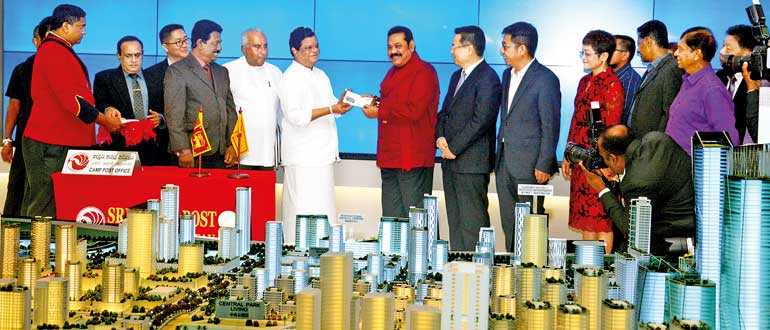Saturday Jan 11, 2025
Saturday Jan 11, 2025
Thursday, 12 December 2019 03:18 - - {{hitsCtrl.values.hits}}

Sri Lanka’s multi-billion dollar project Port City Colombo is now open for business. Five years into its making, the reclamation of land is complete, and the project company is directing their energy towards making it commercially viable. The new city is positioned not only as an immense draw for Colombo’s Central Business District but also as a catalyst for investment in Sri Lanka.
At a ceremony to mark the project’s entry into the second phase of construction, at the newly constructed sales gallery, on the reclaimed land, Port City Colombo was issued a commemorative stamp and a first day cover. Prime Minister Mahinda Rajapaksa was the Chief Guest at the ceremony. He was accompanied by Chinese Ambassador to Sri Lanka Cheng Xueyuan. Also among the other key invitees were Information and Communications Technology Minister Bandula Gunawardena, State Minister of Urban Development Gamini Lokuge, China Harbour Engineering Company (CHEC) President Tang Qiaoliang, Secretary to the Ministry of Urban Development, Water Supply and Housing Facilities Dr. Priyath Bandu Wickrama, and Senior Advisor to the Prime Minister Ajith Nivard Cabraal.
In a special interview given on the sidelines to the launch, Tang Qiaoliang, President of China Harbour Engineering Corporation (CHEC), parent company of CHEC Port City Colombo, said, “The timing of the launch of Port City is significant because this is the era of development for South Asia. Asia as a whole has been developing in waves, from the end of the Second World War to the present day, and this is the final stage. With India’s economy booming, other South Asian countries have begun to follow, and now, Sri Lanka is on the verge of taking that quantum leap in economic development.”
The CHEC President pointed towards the sustainable development process the project has gone through and the inclusive practices it had employed. Drawing attention to the systems used in building the land mass from foundation up, Tang said the Company did not hold back on employing the best. “Whilst Chinese experts were a part of the construction, engineering and modelling process, we also engaged the best expertise from around the world. Some of these experts were involved in the design of the city while others were more specifically involved in engineering and construction aspects. So with all these international experts working together, it has been an international city from the very inception.”
Port City Colombo is a unique development project not only for Sri Lanka and its people but for the entire region. It will be a game changer that will have a significant impact socially, economically and environmentally. Benchmarking international standards, Port City launched Development Control Regulations (DCR) in 2018. The DCR has a detailed plan to be followed in all areas such as Urban Design, Utilities, Landscape and Sustainability, which are compulsory for all developers within Port City.
On the sustainability side for example, water systems will be designed on the principles of conservation and efficiency. Rainwater will be reused to cater for the demand of flushing and irrigation/gardening within the plot to minimise the use of potable water. Energy efficient and environment friendly systems (electrical, pumping and ring main system) will minimise losses.
91 hectares of the reclaimed land area would comprise roads, public spaces, and utility areas, while approximately 45 hectares will be set aside for public parks. Four thousand trees will be planted within the new city, creating a green lung for the CBD. A sustainable design criteria has been given as a guideline for architecture and design of buildings within the new City in addition to plant palettes. The design would incorporate corridors for wildlife that would naturally establish themselves in the created landscape. Bird migration and nesting is also taken into consideration, to mitigate the risks associated with birds flying into glazed surfaces, while the wildlife corridors would allow for safe movement of animals between adjacent habitats.
Tang further stressed on the global connectivity and local essence intrinsic to the project, which he said comes from it being a part of China’s Belt and Road Initiative. He said that the new city needed to be looked at as an opportunity, because it not just connects Sri Lanka to China, but connects the island to the entire world. While many would see it as globalisation, the president of CHEC says the project was a true example of glocalisation, where it thinks local, and acts global. “Every Sri Lankan must know that even though we are marketing this as an international city it is first and foremost, a Sri Lankan city. Today, we celebrate the vesting of this plot of 269 hectares of land as a part of Sri Lanka. And every bit of the strategy we employ has first to be connected to what is Sri Lankan. It is from this platform that we can act global — from marketing to investments, to lifestyle and sustainability.”
Port City will soon be investing in the first building to come up on the new land, which would be the Colombo International Financial Centre (CIFC) complex.
The launch ended with a colourful display of pyrotechnics specially brought in from China. And as the night sky filled with airbursts, comets, fireballs and line rockets, it drew a fitting end to the celebrations as thousands thronged the Galle Face Green, to enjoy a fireworks display never before witnessed in Sri Lanka.